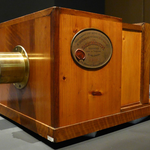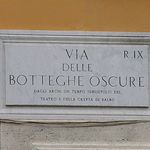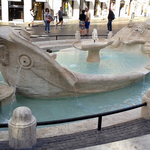Terme di Caracalla
Though Romans lived in the advanced society with the hydraulic system they do not have water at home.
People who lived in the insulae, (roman apartment house) always suffered from the dust. The smoke of torches and stoves formed a grey cloud hanging between the home walls. So plunging into the swimming pools of thermal baths was more than
a pleasure, it was a necessity.
The entry was free: the state financed them as a social service.
The Baths of Caracalla or Antonian Baths are a cyclopean complex of ruins forming one of the most picturesque visions of ancient Rome.
The construction was begun by emperor Settimio Severo in 206 B.C. but was completed ten years later by his son Caracalla. Surrounded by the outside walls of Elagabalus and Alessandro Severo, restored by Aurelio, they were the most splendid baths in Rome. They were still working in the VIth century when vitige Goths made them out of use having destructed the water system which was of the extraordinary perfection.
The planimetry repeats the established type until the IInd century of the Empire. A big central building measured 220 X114 meters. It was surrounded by gardens,gyms,libraries and premises aimed for services within the very wide rectangular circle which occupied a space of about 400X330 meters.
It was supposed that the establishment contained individual baths and common basins for the complex of 1600 bathers. Huge cisterns with a capacity of 80.000 litres provided water arriving from a special branch of the Acqua Marcia, the aqueduct built by Antonino Pious in 140 A.C.
Taking a bath was a rite with precise rules: one begins it with sweeting in a small overheated room so-called sudatoria then passed under a hot shower with the jets in thecaldarium.
They cleaned the body with the blades of the strigil then reached the vast space filled with hot water tepidarium and from there one had an access to frigidarium, the swimming pool of icy water. Here one could dive, swim and have a relaxing massage.
But normally washing was not the main reason for visiting thermal baths. However Caracalla was particularly an ideal place for meeting and chatting. Under the shower the plots were thought over,in the swimming pool love stories were twisted since it was used both by men and women. The attempt of the sex separations (initially only men and then only women) was abolished because of the protests of women who felt discriminated.
The brick structure and the boldness of architectural forms were admirable and some parts of the structure were devised for the local premises and for the heating systems.
Beyond being all laid by polychrome marble and by metal and animated by water jets these thermal baths had the most gorgeous sculptural decoration that include the most famous marbles of the Farnese collection (today they are in the National museum of Naples), Hercules of Glicone, the sculptural group of Toro Farnese, the Flora. The mosaics of athletics are already placed in the Lateran museum.
In the basement of the Thermal Baths there is the Mitreo, the sanctuary of the Persian god Mitra who was very much in fashion in the time of the Roman Imperial court.
For many years during summer seasons performances of lyric are hold between the ruins of Caracalla Thermal baths. The imposing wooden scale for spectators and special equipment allowed to arrange the performances at the high level. Today the performances are suspended according to the wish of the Direction of the Beautiful Arts.
The Caracalla thermal baths are located in the center of the huge green zone (Celimontana villa, the park of Porta Capena and the park of the Scipioni) crossed by the first stretch of the Via Appia.
After the construction of the Aurelian Walls that stretch became the city part of the ancient Appia Antica, enclosed into Porta Capena (which is between Celio e l'Aventino) and Porta San Sebastiano (almost Porta Appia) that today corresponds
to the Via delle Terme Caracalla and the Via di Porta San Sebastiano.
The Via delle Terme Caracalla which is nowadays an archaeological passage crosses the park of Porta Capena with its double tree lines of high mediterranean pine-trees and low holm-oaks. It was built up in 1911 by initiative of Guido Baccelli who was a minister of the Public Education several times from 1880 to 1900. At the end of the road almost in front of the admission to the thermal bath there is the church of Saint Nereo and Achilleo, already titulus fasiolae because of the legend telling about Saint Peter who ran away from the Mamertino jail and lost here the bandage binding the sore from chains attacked to the foot. Remembered since the church was redone in the year 337 by Lion III, then rebuilt entirely in the XVth century, during the following restoration it was decorated by frescos ordered by Cardinal Baronio in 1597. In front of the modest façade with kiosk-formed profile there is a Roman column of granite lying on two columns with a beautiful capital adorned by lion heads and surmounted by a cross.
The Park of Porta Capena is crossed by the viale Guido Baccelli clivus Delphini, This street starts from the Via delle Terme di Caracalla and leads to the Largo delle Terme di Caracalla passing by the same thermal bath from the rear part.From this point it's possible to admire them in all their beauty and to see the church of Santa Balbina built up in the IVth century on the site of the house of the consul Lucio Fabio Cilone (204).
The Via delle Terme di Caracalla ends in the wide square Numa Pompilio from which spread into three roads.
The Viale delle Terme of Caracalla that separate the Park of Porta Capena from the park of the Scipioni. It reaches the Largo delle Terme di Caracalla and crosses the Porta Ardeatina arriving to the Cristoforo Columbus that connects the centre of Rome with the EUR and the sea.
The Via di Porta San Sebastiano crosses all the park of the Scipioni and arrives to the Porta San Sebastiano from which the Appia Antica starts.
Via Druso that together with the Via della Navicella reaches the Villa Celimontana on the top of the San Giovanni in Laterano.

 The records of Rome. Big numbers, not always enviable, for a big city.
The records of Rome. Big numbers, not always enviable, for a big city. New Phot-O-Matic section. To spend some time looking at photos (also) of Rome.
New Phot-O-Matic section. To spend some time looking at photos (also) of Rome. The administrative, urban, toponymic and imaginative subdivisions of Rome.
The administrative, urban, toponymic and imaginative subdivisions of Rome. Notice for tourists: in Rome you drink for free. Historical fountains and 'big noses'.
Notice for tourists: in Rome you drink for free. Historical fountains and 'big noses'. Free museums return on the first Sunday of the month.
Free museums return on the first Sunday of the month.